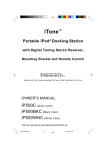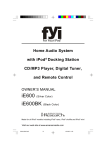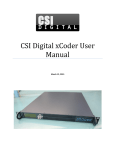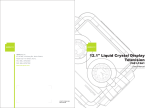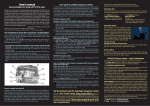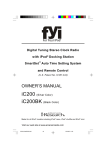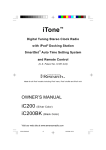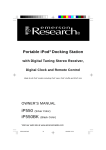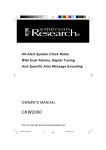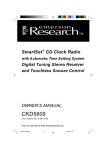Download Emerson iP500 Owner`s manual
Transcript
R Portable iPod® Docking Station with Digital Tuning Stereo Receiver, Mounting Bracket and Remote Control Made for all iPod ® models including iPod ® nano, iPod ® shuffle and iPod ® mini OWNER’S MANUAL iP500 (Silver Color) iP500BK (Black Color) iP500WH (White Color) Visit our web site at www.emersonradio.com iP500_042307.p65 44 23/4/2007, 17:01 CAUT I ON TO PREVENT FIRE OR SHOCK HAZARD, DO NOT USE THIS PLUG WITH AN EXTENSION CORD, RECEPTACLE OR OTHER OUTLET UNLESS THE BLADES CAN BE FULLY INSERTED TO PREVENT BLADE EXPOSURE. TO PREVENT FIRE OR SHOCK HAZARD, DO NOT EXPOSE THIS APPLIANCE TO RAIN OR MOISTURE. C AU T I O N ! RISK OF ELECTRIC SHOCK DO NOT OPEN The lightning flash with arrowhead symbol, within an equilateral triangle is intended to alert the user to the presence of uninsulated ‘dangerous voltage’ within the product’s enclosure that may be of sufficient magnitude to constitute a risk of electric shock to persons. WARNING: TO REDUCE THE RISK OF ELECTRIC SHOCK DO NOT REMOVE COVER (OR BACK), NO USER SERVICEABLE PARTS INSIDE REFER SERVICING TO QUALIFIED SERVICE PERSONNEL. The exclamation point within an equilateral triangle is intended to alert the user to the presence of important operating and maintenance (ser vi ci ng) instr ucti ons in the liter ature accompanying the appl iance. The Caution Marking maybe located at the bottom enclosure of the apparatus. IMPORTANT SAFETY INSTRUCTIONS 1.) Read these instructions. Keep these instructions. Follow all instructions. Heed all warnings. 2.) Do not use this apparatus near water. 3.) Clean only with dry cloth. 4.) Do not block any ventilation openings. Install in accordance with the manufacturer’s instructions. 5.) Do not install near any heat sources such as radiators, heat registers, stoves, or other apparatus (including amplifiers) that produce heat. 6.) Do not defeat the safety purpose of the polarized or grounding-type plug. A polarized plug has two blades with one wider than the other. A grounding type plug has two blades and a third grounding prong. The wide blade or the third prong is provided for your safety. If the provided plug does not fit into your outlet, consult an electrician for replacement of the obsolete outlet. 7.) Protect the power cord from being walked on or pinched particularly at plugs, convenience receptacles, and the point where they exit from the apparatus. 8.) Only use attachments / accessories specified by the manufacturer. 9.) Unplug this apparatus during lightning storms or when unused for long periods of time. 10.) Refer all servicing to qualified service personnel. Servicing is required when the apparatus has been damaged in any way, such as power-supply cord or plug is damaged, liquid has been spilled or objects have fallen into the apparatus, the apparatus has been exposed to rain or moisture, does not operate normally, or has been dropped. 11.) This appliance shall not be exposed to dripping or splashing water and no object filled with liquids such as vases shall be placed on the apparatus. 12.) Use only with the cart, stand, tripod, bracket, or table specified by the manufacturer, or sold with the apparatus. When a cart is used, use caution when moving the cart/apparatus combination to avoid injury from tip-over. 13.) Do not overload wall outlet. Use only power source as indicated. 14.) Use replacement parts as specified by the manufacturer. 15.) The product may be mounted to a wall only if recommended by the manufacturer. 16.) Upon completion of any service or repairs to this product, ask the service technician to perform safety checks. 1 iP500_042307.p65 1 23/4/2007, 17:00 Thank you for purchasing this Portable iPod ® Docking Station from Emerson Research. This compact portable unit allows you to listen to any dockable iPod® (available as of January 2006) through the built in speakers, for those times when you want to share you music with others, or when listening through your ear buds is simply not an option. We've even provided an iPod® compatible USB connector to allow connection of your iPod® Shuffle as well. And as long as your system is connected to an AC outlet with the included AC adapter it will also charge the battery of any iPod® connected to the docking station. There’s also a built in digital tuner with 20 preset station memories, a digital clock that allows you to fall asleep and wake up to the radio or your iPod® , and a full function remote control. And we've included a folding bracket that can be used to mount your system on a wall or below a kitchen cabinet. The system can be operated on 6 “AA” batteries (plus 2 for clock and tuner memory back up) or normal 120V AC house current (AC adapter included). And we've even included an auxiliary input (AUX IN) jack so you can also connect other MP3 players, personal CD players, or any other external device that has a headphone jack. We have taken great care to insure that your system was in perfect working order when it left our factory. If you experience any problems with the set up or operation of this system, please do not return it to the retail store. Please call the Emerson Customer Service hotline, toll free, at 1-800-898-9020, Monday through Friday between the hours of 9:00 AM and 5:00 PM Central Time. One of our representatives will try to resolve the problem for you. If the problem cannot be resolved by phone you will be advised how to obtain service or a replacement unit. Once again, thank you for purchasing this portable iPod® docking station from Emerson Research. iPod® is a trademark of Apple Computer Inc., registered in the U.S. and other countries. 2 iP500_042307.p65 2 23/4/2007, 17:00 I M P O R TAN T N O T E S • Avoid installing this unit in places • Operate controls and switches as exposed to direct sunlight or close to described in the manual. heat radiating appliances such as • Before turning on the power, make electric heaters, on top of other stereo certain that the AC adapter is properly equipment that radiates too much installed. heat, places lacking ventilation or • When moving the set, be sure to first dusty areas, places subject to disconnect the AC adapter. constant vibration and/or humid or moist areas. FCC Information This equipment has been tested and found to comply with the limits for a Class B digital device, pursuant to Part 15 of the FCC Rules. These limits are designed to provide reasonable protection against harmful interference in a residential installation. This equipment generates, uses, and can radiate radio frequency energy and, if not installed and used in accordance with the instructions, may cause harmful interference to radio communications. However, there is no guarantee that interference will not occur in a particular installation. If this equipment does cause harmful interference to radio or television reception, which can be determined by turning the equipment off and on, the user is encouraged to try to correct the interference by one or more of the following measures: • Reorient or relocate the receiving antenna. • Increase the separation between the equipment and receiver. • Connect the equipment into an outlet on a circuit different from that to which the receiver is connected. • Consult the dealer or an experienced radio/TV technician for help. This device complies with Part 15 of the FCC Rules. Operation is subject to the following two conditions: (1) This device may not cause harmful interference, and (2) This device must accept any interference received, including interference that may cause undesired operation. Changes or modifications not expressly approved by the party responsible for compliance could void the user’s authority to operate the equipment. 3 iP500_042307.p65 3 23/4/2007, 17:00 PREPARATION FOR USE Unpacking and Set-up • This carton contains the main unit, 6 plastic adapters to insure that all dockable iPod® s fit securely in the docking station, the AC adapter, the mounting bracket and mounting hardware, and the remote control. Confirm that you have all of these items and make sure that nothing is accidentally discarded with the packing materials. • We recommend that, if possible, you save the carton and packing materials in the event that your unit ever needs to be returned for service. Using the original carton and packing materials is the only way to protect your unit from damage during shipment. • Remove the paper “dummy iPod® ” from the docking area and discard it. That is for store display purpose only. To remove the “dummy iPod® ” slide the docking cradle upward to remove it from the front panel. Turn the cradle over and push the docking connector cover out of the cradle as shown in the following illustration, and then remove the “dummy iPod® ”. (Dummy iPod® ) (Docking Connector Cover) • Remove any descriptive labels or stickers from the front or top panels. Do not remove any labels from the back or bottom panels. 4 iP500_042307.p65 4 23/4/2007, 17:00 Power Sources This system is designed to operate on 6 “AA” batteries (plus 2 for clock and tuner memory back up), not included, or on normal 120V 60Hz AC house current with the included AC adapter. Attempting to operate this system on any other power source may cause damage to the unit, and such damage is not covered by your warranty. AC Operation Insert the small female plug of the AC adapter into the “DC IN 10V” jack on the back panel. (AC Adapter, Included) (“DC IN 10V” Jack) (120V AC Outlet) Connect the AC adapter housing to your normal 120V 60Hz AC household outlet. 5 iP500_042307.p65 5 23/4/2007, 17:00 Installing The Batteries The battery compartment is located on the back cabinet. We recommend that you place the unit on a soft surface such as a carpet, on a towel or blanket before turning the unit face down to install the batteries. This will prevent any scratches on the cabinet finish. 1.) With the unit face down press both battery cover locking tabs in the direction of the arrow marks and remove the battery compartment cover. 2.) Insert 8 “AA” batteries, not included, in the battery compartment according to the polarity markings engraved in the compartment. If the batteries are inserted incorrectly the unit will not work. NOTE: We recommend that you use a well-known brand of alkaline batteries for longest life and best performance. 3.) Replace the battery compartment and make sure that it locks securely in place. IMPORTANT: In order to operate the unit on batteries the AC adapter must be disconnected from the DC IN 10V jack on the back cabinet. 6 iP500_042307.p65 6 23/4/2007, 17:00 Low Battery Warning and Auto Shutoff When the 6 “AA” main power batteries that operate the radio and iPod® become too weak for normal operation the Low Battery Indicator will begin to flash in the display. This is your indication that it's time to replace the 6 “AA” batteries. Approximately 90 seconds after the Low Battery Indicator begins flashing the system will shut off automatically. NOTE: The Low Battery Warning Indicator only applies to the 6 “AA” main power batteries that operate the radio and the iPod® , not the 2 “AA” back-up batteries for the clock and tuner memories. The 6 main power batteries should be changed when the low battery warning indicator begins flashing. The 2 back-up batteries should be changed approximately every 12 months. Battery Precautions • Replacement of batteries must be done by an adult. • Do not mix old and new batteries. • Do not mix alkaline, standard (carbon-zinc) or rechargeable (nickel-cadmium) batteries. • The supply terminals are not to be short-circuited. • Non-rechargeable batteries are not to be recharged. • Exhausted batteries are to be removed. • Only batteries of the equivalent type are to be used. • Batteries are to be inserted with the correct polarity. • Dispose of batteries properly. Do not dispose of batteries in fire. The batteries may explode or leak. 7 iP500_042307.p65 7 23/4/2007, 17:00 FM Antenna (On Back Panel) The FM antenna wire is attached to a screw terminal on the bottom cabinet. Unwind the antenna wire completely and extend it to its full length before returning the cabinet to its upright position. EXTERNAL FM ANT. It may be necessary to adjust the direction of the FM antenna wire until you find the position that provides the best reception. Protect Your Furniture This model is equipped with non-skid rubber 'feet' to prevent the product from moving when you operate the controls. These 'feet' are made from non-migrating rubber material specially formulated to avoid leaving any marks or stains on your furniture. However certain types of oil based furniture polishes, wood preservatives, or cleaning sprays may cause the rubber 'feet' to soften, and leave marks or a rubber residue on the furniture. To prevent any damage to your furniture we strongly recommend that you purchase small self-adhesive felt pads, available at hardware stores and home improvement centers everywhere, and apply these pads to the bottom of the rubber 'feet' before you place the product on fine wooden furniture. 8 iP500_042307.p65 8 23/4/2007, 17:00 Reset Button (On BACK Panel) If this system is subjected to a sudden power surge, or excessive static electricity, the internal computer will shut down temporarily to prevent any permanent damage to the system. If you find that the system does not respond when you operate the controls on the top panel or the remote handset, you have probably experienced a sudden power surge that caused the internal computer to shut down. To correct this problem and reset the internal computer, first disconnect the AC power cord for 60 seconds and then plug it in again. If this still does not correct the problem, use the point of a ballpoint pen, a toothpick, a straightened paper clip, or similar object to press the RESET button, located in a small hole near the battery compartment door, under the door looking tab. RESET Pressing the RESET button will reset the system and clear the system memory. The system should then operate normally again, however it will be necessary to reset the clock, the alarm setting, and re-enter all of your preset stations in the tuner memory after pressing the RESET button. 9 iP500_042307.p65 9 23/4/2007, 17:00 Remote Control The remote control supplied with this system allows you to operate all of the features and functions found on the main unit control panel. The remote receiver is located in the upper right corner of the front panel. To operate the remote control, aim the handset at the receiver on the front panel and press the appropriate button on the remote handset. The effective operating distance of the remote control is approximately 15 feet from the remote receiver on the front panel. IMPORTANT! Please note that the iPod ® Shuffle has no interface to accept commands from a remote control. The remote control of this system will not operate an iPod ® Shuffle. You must use the controls on the Shuffle itself to operate an iPod® Shuffle. Remote Control Battery The remote control operates on one 3V lithium ‘button’battery, Type CR2032 or equivalent. The battery was installed in the remote when you purchased this system. To preserve the life of the battery a small clear plastic spacer tab is installed between the battery and the battery terminal. This tab must be removed before the remote control can be used. To remove the tab simply pull it out of the battery compartment, as shown, and discard it. 10 iP500_042307.p65 10 23/4/2007, 17:00 The original battery should be able to power the remote control for 12 to 18 months or even longer, depending on the frequency of use. When the operation of the remote becomes intermittent or fails completely you should replace the battery as soon as possible. To replace the battery, put the remote control face down and press the battery holder locking tab in the direction of the arrow and slide the battery holder out of the remote control. Install a fresh CR2032 battery in the holder as shown and slide the holder back in to the remote control. IMPORTANT: Be sure to dispose of the old battery properly. Do not leave it around where a young child or a pet might play with or swallow it. If the battery is swallowed, contact a physician immediately. Do not dispose of the old battery in a fire. The battery could leak or explode if incinerated. CAUTION DANGER OF EXPLOSION IF BATTERY IS INCORRECTLY REPLACED. REPLACE ONLY WITH THE SAME OR EQUIVALENT TYPE. 11 iP500_042307.p65 11 23/4/2007, 17:00 LOCATION OF CONTROLS AND INDICATORS 2 Top Panel 1 14 12 13 10 11 9 8 7 5 4 3 6 Front Panel 18 17 16 15 15 19 Back Panel 2 23 22 23 22 21 20 28 27 26 25 24 12 iP500_042307.p65 12 23/4/2007, 17:00 Power Button - Press to turn the unit ‘On’or ‘Off’. 1.) 2.) Carrying Handle. 3.) Volume + / Volume – Buttons - Used to adjust volume level. In power ‘Off’ mode, used to adjust the Minutes display. 4.) Tuning + ( ) / Tuning – ( ) Buttons - In radio mode, tunes to the desired station. In iPod mode, skips tracks or performs high-speed search. In power ‘Off’mode, used to adjust the Hour display. 5.) iPod Play/Pause Button - Press to start iPod® playback. Press again to pause. Press and hold to shut iPod® ‘Off’. 6.) Alarm On/Off Button - Activates the alarm, stops the alarm, and deactivates the alarm. 7.) Snooze/Light Button - Activates the snooze function. Switches the display and front panel lighting ‘On’or ‘Off’. 8.) iPod® Shuffle USB Connector - For iPod® Shuffle connection. 9.) iPod® Dock - For all dockable iPod® s with 30-pin connector on the bottom. 10.) Function Button - Press repeatedly to switch among iPod, iPod shuffle, AUX, FM Band, and AM Band modes. 11.) Memory Button - Saves radio stations in the tuner memory. 12.) Mode Button - Press repeatedly to switch FM ST and MONO mode. In power ‘Off’mode, selects the specific function to be adjusted. 13.) CH + / CH – (Direct Channel) Buttons - In radio mode, selects the desired preset station. 14.) Sleep Button - Activates the sleep timer and sets the sleep timer duration. 15.) Speakers. 16.) Docking Cradle. 17.) Power ‘On’LED Indicator. 18.) Remote Control Sensor. 19.) Main Display. 20.) Mounting Bracket Secure Screw Hole. 21.) Battery Compartment. 22.) RESET Button (Under Battery Door Tab) - Resets the internal computer after a power surge. 23.) Mounting Bracket Hooking Holes. 24.) EXTERNAL FM ANT. Terminal and FM Wire Antenna. 25.) DC IN 10V Input Jack. 26.) Phones (Stereo Headphone) Jack. 27.) AUX IN (Auxiliary Input) Jack - For connection of external audio sources. 28.) Foldable Stand. 13 iP500_042307.p65 13 23/4/2007, 17:00 LCD Display 5 6 7 8 4 9 3 2 10 1 11 15 14 13 12 1.) AUX Select Indicator. 2.) Clock, Radio Frequencies Display. 3.) Battery Low Indicator. 4.) Clock PM Indicator. 5.) Radio Band AM FM Indicators. 6.) BUZ, RAD, iPod Alarm Indicators. 7.) SNOOZE Timer Indicator. 8.) SLEEP Timer Indicator. 9.) MEM (Memory) Indicator. 10.) Month/Date, Volume Level (00-30), Radio Channel (01-10) Display. 11.) VOL Indicator. 12.) CH Indicator. 13.) FM MONO ST Indicators. 14.) iPod shuffle Select Indicator. 15.) iPod Select Indicator. 14 iP500_042307.p65 14 23/4/2007, 17:00 Remote Control 8 9 7 6 10 5 4 11 12 3 13 2 14 1 15 1.) iPod PLAY/PAUSE Button - Press to start iPod® playback. Press again to pause. Press and hold to shut iPod® ‘Off’. 2.) iPod REV. Button - In iPod mode, reverse skips tracks or performs highspeed search. 3.) SLEEP Button - Activates the sleep timer and sets the sleep timer duration. 4.) Mode Button - Press repeatedly to switch FM ST and MONO mode. In power ‘Off’mode, selects the specific function to be adjusted. 5.) CH + / CH – (Direct Channel) Buttons - In radio mode, selects the desired preset station. 6.) TUN / TUN Buttons - In radio mode, tunes to the desired station. In power ‘Off’mode, used to adjust the Hour display. 15 iP500_042307.p65 15 23/4/2007, 17:00 7.) SNOOZE/LIGHT Button - Activates the snooze function. Switches the display and front panel lighting ‘On’or ‘Off’. 8.) Infrared Transmitter. 9.) POWER ON/OFF Button - Press to turn the unit ‘On’or ‘Off’. 10.) VOLUME + / VOLUME – Buttons - Used to adjust volume level and for setting the Minutes display. 11.) MEMORY Button - Saves radio stations in the tuner memory. 12.) FUNCTION Button - Press repeatedly to switch among iPod, iPod shuffle, AUX, FM Band, and AM Band modes. 13.) ALARM ON/OFF Button - Activates the alarm, stops the alarm, and deactivates the alarm. 14.) iPod FWD. Button - In iPod mode, forward skips tracks or performs highspeed search. 15.) Lithium Battery Compartment. 16 iP500_042307.p65 16 23/4/2007, 17:00 OPERATING INSTRUCTIONS • Make sure that you have installed the 8 “AA” batteries or have connected the unit to your household AC outlet with the supplied AC adapter. • Make sure that you have removed the clear plastic battery spacer tab from the remote control. • Make sure that you have unwound the FM antenna wire and extended it to its full length. Setting The Time The first time you connect this system to your AC outlet the display will turn on and show AM “12:00” and “1/ 1” (January 1st). The colon will begin to flash indicating that the clock is running. 1.) Press the Mode button 3 times. The time display will begin to flash. 2.) Press the Tuning + ( )/–( ) buttons on the top panel or TUN / buttons on the remote control to set the Hour display forward or backward to the correct hour. Example: PM 2:00. Be sure to observe the PM indicator to confirm that you have set the hour correctly. If no PM indicator appears the time display is AM. 3.) Press the Volume + or Volume – buttons to set the Minute display forward or backward to the correct minute. Example: PM 2:45. 4.) Within 10 seconds after you adjust the time the display will stop flashing and the clock begins to run. NOTE: If the display stops flashing before you finish setting the correct time, your setting will not be completed. If this occurs, repeat steps 1 through 3 and be sure to complete your settings while the display is still flashing. 17 iP500_042307.p65 17 23/4/2007, 17:00 Setting The Time Display Mode (12 Hour/24 Hour Display) You have the option of displaying the time in 12-Hour or 24-Hour modes. 12-Hour Mode - The time is displayed in 12-hour cycles with PM indicator. This is the factory default setting. 24-Hour Mode - The time is displayed in 24-hour cycles with no PM indicator. This is sometimes referred to as “Military Time”. For example, “PM 6:00” would be displayed as “18:00”. If you wish to change the display from the 12-hour mode to the 24-hour mode, press the Mode button 4 times, or until “12hr” is flashing in the display. Then press either the Tuning + ( / )/– ( ) buttons on the top panel or TUN buttons on the remote control to alternatively to switch between the 12-hour and 24-hour display modes. After 10 seconds the display will return to the correct time, and the time will be displayed in the mode you selected. Setting The Year Press the Mode button 5 times, or until the year “2006” starts flashing in the display. If necessary, while the year is flashing press the Tuning + ( panel or TUN ) button on the top button on the remote control to advance the display to the correct year. After 10 seconds the display returns to the correct time. Setting The Month and Date Press the Mode button 6 times, or until “1/ 1” is flashing in the display. Press the Tuning + ( ) / – ( ) buttons on the top panel or TUN / buttons on the remote control to set the display to the correct Month then press the Volume + or Volume – buttons to set the display to the correct Date. After 10 seconds the display returns to the correct time, month, and date. 18 iP500_042307.p65 18 23/4/2007, 17:00 Volume Controls Press the Volume + or Volume – buttons to increase or decrease the volume level. The MONTH/DATE display changes to a VOL (volume) level indicator during volume adjustments. The display ranges from “00” (minimum) to “30” (maximum). 10 seconds after adjusting the volume level the indicator returns to the MONTH/DATE display in AUX and iPod modes. NOTE: When you connect an iPod® to the docking station of this system the volume controls on the iPod® click-wheel are automatically disabled. Use the volume controls on this system to control the iPod® volume. When you install an iPod® Shuffle in the docking station of this system you will need to use both the volume controls on the Shuffle and the volume controls on this system to set the volume to the desired level. 19 iP500_042307.p65 19 23/4/2007, 17:00 Listening To The Radio 1.) Press the Power button to turns the unit ‘On’. The display lighting and the Power LED indicator come ‘On’. 2.) Press the Function button to select the Radio function. The first time you select the Radio function the display will show: “FM 87.5 MHz ST”. Press the Function button once more to select the AM band. The first time you select the AM band the display will show “AM 520 KHz”. 3.) After selecting the desired band, tune to the desired station by either the Automatic or Manual Tuning methods as follows: • Manual Tuning Repeatedly press the Tuning + ( )/–( ) buttons on the top panel or TUN / buttons on the remote control until the frequency of the desired station appears on the display. • Automatic Tuning Depress and hold either the Tuning + ( TUN / )/–( ) buttons on the top panel or buttons on the remote control until the display begins to move, then release the buttons. The tuner will search up or down the band for the next strong station and stop on that station. Repeat this procedure until the tuner stops on the desired station. NOTES: A.) Use the Manual Tuning method to tune to weak stations that are bypassed during Automatic Tuning. B.) If you are listening to a very weak FM Stereo station, try pressing the Mode button to select the FM MONO mode. This will normally improve the reception although the sound will no longer be in stereo. 20 iP500_042307.p65 20 23/4/2007, 17:00 4.) Adjust the Volume + / – controls as desired. 5.) When you are finished listening press the Power button to shut the system ‘Off’. The display lighting and the Power LED indicator go off. The display changes from radio frequency to the correct time, month and date display. NOTE: The system remembers the last station you were listening to, plus the Volume settings you selected before switching the power off, and automatically returns to those same settings when the radio is switched on again. Antenna Information AM The AM bar antenna is inside the cabinet. It may be necessary to adjust the position of the cabinet until the internal antenna is receiving the strongest possible signal. FM Make sure that the FM wire antenna is firmly attached to the screw terminal on the back cabinet. It may be necessary to adjust the position of the FM wire antenna to find the position that provides the best FM reception. 21 iP500_042307.p65 21 23/4/2007, 17:00 Presetting Station In The Tuner Memory The tuner in this system has 20 preset station memories. You can store up to 10 of your favorite FM stations and 10 of your favorite AM stations in the memory for easy and immediate recall at any time. 1.) Tune to the first station you wish to memorize using either the Manual or Automatic Tuning methods described on page 20. Example: FM 93.5 MHz ST. 2.) When the desired station appears on the display press the Memory button once. The MEM indicator and the CH 01 indicators flash in the display. 3.) Within 10 seconds, while the indicators are still flashing, press the Memory button again to enter your station in memory channel 01. The MEM and CH 01 indicators stop flashing. The CH 01 indicator remains in the display for 10 seconds and then disappears. 4.) Tune to the next station you wish memorize. When the desired frequency appears on the display, press the Memory button, then press theCH + button to advance the memory channel display from 01 to 02. Press the Memory button once more to store the station in memory channel 02. 5.) Repeat step 4, selecting a different memory channel number each time until you have entered up to 10 FM stations in the tuner memory. 6.) Press the Function button to select the AM band and then repeat steps 1 through 5 to enter up to 10 AM stations in the tuner memory. 22 iP500_042307.p65 22 23/4/2007, 17:00 Recalling Preset Stations Press the Function button to select the desired band, then press the CH + or CH – buttons to scroll through the preset memory stations. Changing Preset Stations 1.) Tune to the new station that you wish to memorize. 2.) Press the Memory button, then press the CH + or CH – buttons to select the preset memory channel number that you wish to change. 3.) While the indicators are flashing, press the Memory button again. The new station is entered into the selected memory channel number and the previously memorized station is deleted. 23 iP500_042307.p65 23 23/4/2007, 17:00 Adjusting The Digital Tuner For Use in Other Countries The tuner in this system can be adjusted for the AM and FM bands and frequency steps used in Europe and Japan in addition to the normal USA settings. The tuner was set for the USA settings at our factory. If this system will be used in the USA there is no need for you to make any adjustments. This information is provided only in the event that this system will be used in another country with different requirements. The AM and FM frequency coverage and the tuner frequency steps available in this system are as follows: USA AM FM EUROPE (EU) JAPAN (JP) (520–1710)kHz (522–1620)kHz (522–1629)kHz 10kHz Steps 9kHz Steps 9kHz Steps (87.5–108)MHz (87.5–108)MHz (76.0–108)MHz 0.1MHz Steps 0.05MHz Steps 0.1MHz Steps To change from the USA broadcast system to another broadcast system proceed as follows: 1.) If necessary, press the Power button to shut the power ‘Off’. 2.) Press the Mode button 7 times. The “USA” indicators flash in the display. 3.) While the display is flashing press either the Tuning + ( )/– ( ) buttons on / buttons on the remote control to alternately the top panel or TUN switch among the “USA”, “EU” (Europe), “JP” (Japan) settings. 4.) Press the Mode button to save the setting and exit the setting mode. 24 iP500_042307.p65 24 23/4/2007, 17:00 25 iP500_042307.p65 23/4/2007, 15:50 ® and 2G iPod® nano models at time of purchase. "Docking Station Dust Cover. Install This Cover In The Docking Station If No iPod® Will Be Docked For An Extended Period of Time." * No adapters provided. Please use the adapters that were included with your 5G iPod Adapters nano (1G) nano (2G) This system includes 5 different adapters designed to allow you to securely connect any “dockable” iPod® model to the docking station. Refer to the chart below to select the proper adapter for your particular iPod® model and insert that adapter into the docking station before connecting your iPod®. NOTE: No adapters are provided for the 5G (fifth generation) 30GB and 60GB iPod®s with video capability, and 2G (second generation) iPod® nano. Please use that adapters that were included with these iPod ®s at time of purchase. They will fit properly into the docking station of this system. We have also included one flat adapter with no opening at all. This serves as a dust cover that can be inserted in the docking station if no iPod® will be connected to system for an extended period of time. iPod ® ADAPTER INFORMATION Connecting and Playing Your ‘Dockable’ iPod ® (Refer To Separate Instructions For The iPod ® Shuffle) IMPORTANT: To avoid any unwanted distortion when listening to your iPod® through the speakers of this system we recommend that you shut off the equalizer in the iPod® before inserting it in the docking station of this system. To shut off the iPod® equalizer, go to the “Main Menu” in your iPod® , scroll to the “Settings” menu, select the “EQ” setting and turn the EQ ‘Off’. 1.) The Hold switch on your iPod® should be set to the ‘Off’position to unlock the click-wheel navigation controls. 2.) Remove the docking cradle from the front panel by sliding the cradle upward as shown. If you have not already done so turn the cradle over and press on the bottom of the connector cover to remove it from the cradle. Discard the paper “dummy iPod® ”. 3. Choose the appropriate adapter for your particular iPod® model from among the 6 adapters supplied with this system and insert the adapter into the docking cradle as shown. (Refer to the iPod adapter chart). Then re-install the docking cradle in the front panel. 26 iP500_042307.p65 26 23/4/2007, 17:00 NOTE: If you are using either the 30GB or 60GB fifth generation iPod ® models with video capability, or the 2G (Second Generation) iPod® nano, use the adapters that were supplied with the iPod® s at time of purchase. They will fit correctly in the docking cradle of this system. IMPORTANT! • If you are using a “1G (First Generation) iPod ® nano” you must slide the docking connector to the ‘left’position before inserting the required adapter as shown in the following illustrations: • If later you decide to install a different iPod® model you must remove the nano adapter from the docking cradle and slide the docking connector back to the ‘right’position before inserting the appropriate adapter. 3.) Slide your iPod® into the adapter and make sure that it slides down as far as possible until it is correctly seated on the iPod® connector. 4.) Press the Power button of this system to turn the power ‘On’. 5.) Press the Function button of this system to select the iPod function. The “iPod” indicator appears in the display. 27 iP500_042307.p65 27 23/4/2007, 17:01 6.) If necessary, press the iPod PLAY/PAUSE button to begin playback. 7.) Press the Volume + / – buttons on this system to adjust the iPod® volume level. NOTE: When your iPod® is docked in this system the click-wheel volume control on the iPod ® is automatically defeated. The volume can only be adjusted with the controls on this system. 8.) To skip forward or back to other iPod® tracks press the Tuning + ( )/–( ) buttons on the top panel or iPod FWD. / iPod REV. buttons on the remote control, or use the iPod® click-wheel navigation controls. To perform high-speed search within tracks depress and hold the Tuning + ( )/–( ) buttons on the top panel or iPod FWD. / iPod REV. buttons on the remote control, or use the iPod® click-wheel navigation controls as usual. Release the controls when you hear the desired passage and normal playback will resume at that point. 9.) To pause during playback, press the iPod PLAY/PAUSE button again. Press once more to cancel pause and resume playback. 10.) To shut the iPod® off, depress and hold the iPod PLAY/PAUSE button until the iPod® stops playing and the display goes blank, or the ‘Charging’ screen appears. NOTE: If you wish to navigate through the iPod® menu to select among “Artists”, “Albums”, “Songs”, “Genres” etc., you must use the iPod® click-wheel navigation controls as usual. Those options cannot be selected from the controls on the main unit or the remote. 28 iP500_042307.p65 28 23/4/2007, 17:01 Removing or Changing The iPod ® Adapter If you will be using different ‘dockable’iPod® models with this system you will have to install the appropriate adapter in the docking area for each different iPod® model. The procedure for removing and changing the iPod® adapter is as follows: 1.) Remove your iPod® from the docking station as usual. 2.) Lift up on the docking cradle and remove it from the docking station as shown. 3.) Press on the bottom of the iPod® adapter as shown to remove it from the docking cradle. iPod® Adapter Docking Cradle (Bottom up) 4.) Re-install the docking cradle in the docking station. 5.) Insert the desired iPod® adapter in the docking cradle. 29 iP500_042307.p65 29 23/4/2007, 17:01 Connecting and Playing A 1G (First Generation) iPod® Shuffle The docking station of this system includes an Apple USB connector specifically designed for the 1G (First Generation) iPod® Shuffle with direct USB connector. Note: If you have a new 2G (Second Generation) iPod ® Shuffle you may connect it to the Auxiliary Input jack of this system. Please refer to the connection instructions on page 33. IMPORTANT! • Do not attempt to connect other portable MP3 players or portable USB drives to this iPod® Shuffle USB connector. You can connect MP3 players to the Auxiliary Input (AUX IN) jack of this system but not to the USB connector. This system is not compatible with portable USB storage drives that contain compressed MP3 or WMA audio files. • The iPod® Shuffle has no interface to receive commands from an external controller, therefore you cannot use the iPod the Tuning + ( )/–( PLAY/PAUSE button, ) buttons on the top panel, or the iPod FWD. / iPod REV. buttons on the remote control of this system to operate the iPod® Shuffle. You can only use the controls on the iPod® Shuffle itself. 1.) Set the function switch on your iPod® Shuffle to either the Normal or Shuffle playback position and remove the protective cap. 2.) Connect your iPod® Shuffle to the USB connector on the docking station. It can only be connected one way, with the front panel of the Shuffle facing outward. Original iPod® Shuffle (First Generation) Press the Power button on this system to turn the power ‘On’. 30 iP500_042307.p65 30 23/4/2007, 17:01 3.) Press the Function button on this system to select the iPod® Shuffle function. The “iPodShuffle” indicator appears in the display. 4.) Press the Volume + / – buttons on this system to adjust volume until the Volume Level Indicator display is showing “25”. 5.) Press the iPod Play/Pause button on the iPod® Shuffle to begin playback in either the Normal or Shuffle mode, according to your selection in Step 1 above. iPod PLAY/PAUSE of this system has no effect NOTE: Pressing the for the iPod® Shuffle. 6.) Press the Volume + / – buttons on the iPod® Shuffle to adjust the iPod® volume level. If necessary you can then go back and make final up or down adjustments to the Volume controls on this system. 7.) To skip forward or back, to perform high-speed search, to pause or to stop playback, press the corresponding controls on the iPod® Shuffle as usual. 8.) When you are finished listening, remove the iPod® Shuffle, switch it ‘Off’, and replace the protective cap. 9.) Press the Power button on this system to turn the power ‘Off’. 31 iP500_042307.p65 31 23/4/2007, 17:01 Charging the iPod ® Battery IMPORTANT! The battery charging circuit in this system only functions when this system is being operated on AC power with the included AC adapter. This system will not charge the iPod® batteries when you operating this system on battery power. When your iPod® is connected to the ‘docking’station of this system, and the iPod® is not playing, the iPod ® battery will be recharged automatically. The battery will be charged whether the power of this system is ‘On’or ‘Off’. It will also be charged while you are listening to an external auxiliary music source. NOTE: To prevent interference between the battery charging circuit and the radio in this system the battery charging circuit is turned off while you are listening to the radio. When you shut the radio off, battery charging resumes automatically. 32 iP500_042307.p65 32 23/4/2007, 17:01 Listening To A 2G (Second Generation) iPod® Shuffle, MP3 Player, Or Other External Source This system includes a 3.5mm mini stereo Auxiliary (AUX IN) Input jack on the back panel so that you can easily connect any external audio source with a headphone jack or a Line Out jack and listen to your external source through the speakers of this system. Use the Auxiliary Input jack to connect the new 2G (Second Generation) iPod® shuffle, older non-dockable iPods, other MP3 players, personal CD players, etc. New 2G (Second Generation) iPod® Shuffle 1.) Connect the headphone jack or Line Out jack of your external audio source to the AUX IN In jack on the back panel of this system. NOTE: The connection cable is not included. 2.) Turn on the power switch of your external source and operate it as usual. Switch off any Equalizer or Bass Boost controls on the external source. 3.) Press the Power button of this system to turn the power ‘On’then press the Function button to select the AUX function. The AUX indicator appears in the display. 33 iP500_042307.p65 33 23/4/2007, 17:01 4.) You should hear the sound from your external source through the speakers of this system. NOTE: If you connected the Line Out jack of your external source then you only need to adjust the Volume control of this system. If you connected the headphone jack of your external source then you may need to adjust both the volume control of your external source and the Volume control of this system to find the most desirable volume setting. 5.) When you are finished listening press the Power button of this system to turn the power ‘Off’. Don't forget to switch off the power to your external source as well. NOTE: It is not necessary to disconnect your external source from the AUX IN jack of this system. Stereo Headphone Jack This system includes a 3.5mm mini PHONES (stereo headphone) jack on the back panel so that you can listen privately without disturbing others. When the headphone (not included) is connected to the PHONES jack of this system the internal speakers are automatically shut ‘Off’. IMPORTANT! Before you put on your headphones please reduce the Volume control of this system to a low level. Then put your headphones on and gradually increase the volume to a comfortable listening level. Remember that digital music files can contain both very soft and very loud passages. You should adjust the Volume control to a comfortable level while listening to a louder passage so that you will not experience any discomfort caused by any sudden increase in volume level. The headphones must be disconnected from the PHONES jack in order to listen to the internal speakers again. 34 iP500_042307.p65 34 23/4/2007, 17:01 Alarm, Snooze, And Sleep To Music Functions Setting The Alarm Time and Alarm Mode 1.) If the system power is ‘On’, press the Power button to shut the power ‘Off’. The power must be ‘Off’to set/adjust the alarm time. 2.) With the correct time of day appearing on the display, press the Mode button once. The display changes from current time to alarm time and the alarm time flashes. One of the alarm mode icons also appears in the display. 3.) While the alarm time display is flashing press the Tuning + ( )/– ( ) buttons / buttons on the remote control to set the on the top panel or TUN Hour display forward or backward to the desired wake-up hour. Example: AM 6:00. Be sure to observe the PM indicator to confirm that you have set the hour correctly. If no PM indicator appears the time display is AM. 4.) Press the Volume + or Volume – buttons to set the Minute display forward or backward to the desired wake-up minute. Example: AM 6:45. 5.) When the display is showing the desired wake-up time press the Mode button once more and the Alarm Mode icon (BUZ, RAD, iPod) will begin to flash. 6.) Press the Volume + or Volume – buttons to select the desired wake up mode: BUZ (Buzzer), RAD (Radio), or iPod. 7.) After 10 seconds the alarm display will stop flashing and the correct time display reappears. 35 iP500_042307.p65 35 23/4/2007, 17:01 To Activate or Deactivate The Alarm Press the Alarm On/Off button once on the top panel, or on the remote control, to activate the alarm. One of the alarm mode icons will appear in the time display to confirm that the alarm is ‘On’. Press the Alarm On/Off button again to deactivate the alarm. The alarm icon disappears. Wake-up To Radio 1.) Turn the radio ‘On’, select the station that you wish to hear at the wake-up time, and turn the radio ‘Off’again. 2.) Check and adjust the alarm time setting if necessary and make sure the “ RAD” alarm mode is selected. 3.) Press the Alarm On/Off button to activate the alarm. Make sure the “ RAD” icon appears in the display. 4.) At the selected wake up time the radio will turn on automatically. It starts softly and gradually gets louder. It will continue to play for 60 minutes and then shut off automatically until the following day. 5.) To stop the radio alarm sooner, press the Alarm On/Off button once. The radio stops immediately but the “ RAD” indicator remains in the display and the alarm remains set for the following day. To deactivate the alarm completely press the Alarm On/Off button once more. The “ RAD” indicator disappears. 36 iP500_042307.p65 36 23/4/2007, 17:01 Wake-up To iPod® NOTES: • You cannot wake-up to an iPod® Shuffle connected to the USB port. You can only wake-up to ‘dockable’ iPod ® models that are connected to the 30-pin connector in the docking area. • If you select the “Wake-up To iPod® ” mode but there is no iPod® connected to the dock at the wake-up time, the system will automatically default to the “Wake-up to Buzzer” mode. 1.) Make sure that the iPod® is properly inserted in the docking area and that the HOLD switch on the iPod® is ‘Off’. 2.) Check and adjust the alarm time setting if necessary and make sure the “ iPod” alarm mode is selected. 3.) Press the Alarm On/Off button to activate the alarm. Make sure the “ iPod” icon appears in the display. 4.) At the selected wake up time the iPod® will turn on automatically. It starts softly and gradually gets louder. It will continue to play for 60 minutes and then shut off automatically until the following day. 5.) To stop the iPod alarm sooner, press the Alarm On/Off button once. The iPod® stops immediately but the “ iPod” indicator remains in the display and alarm remains set for the following day. To deactivate the alarm completely press the Alarm On/Off button once more. The “ iPod” indicator disappears. 37 iP500_042307.p65 37 23/4/2007, 17:01 Wake-up To Buzzer With Auto Snooze Function 1.) Check and adjust the alarm time setting if necessary and make sure the “BUZ ” alarm mode is selected. 2.) Press the Alarm On/Off button to activate the alarm. Make sure the “BUZ ” icon appears in the display. 3.) At the selected wake up time the Buzzer will turn on automatically. It continues for 1 minute and then enters the “Auto Snooze” mode. After one minute the buzzer will shut off for 9-10 minutes and then turn on again automatically. This “Buzzer/Auto Snooze” cycle will be repeated three more times, but after the fourth time the alarm will shut off and reset itself for the following day. 4.) To stop the buzzer alarm sooner, press the Alarm On/Off button once. The buzzer stops immediately but the “BUZ ” indicator remains in the display and alarm remains set for the following day. To deactivate the alarm completely, press the Alarm On/Off button once more. The “BUZ ” indicator disappears. Snooze Operation If you need a few minutes extra sleep when the Radio or iPod alarm turns on in the morning, press the Snooze/Light button. The alarm will stop for 9-10 minutes and then turn on again. The Snooze operation may be repeated 3 times but after the 4th time the alarm will not repeat. It will shut off and reset itself for the following day. The buzzer alarm automatically enters the “Auto Snooze” mode after one minute as mentioned above. However you may still use the manual snooze mode for the buzzer alarm by simply pressing the Snooze/Light button as soon as the buzzer alarm turns on. 38 iP500_042307.p65 38 23/4/2007, 17:01 Sleep To Music Timer This feature allows you to fall asleep to the Radio, or your iPod® , for up to 60 minutes, and then the system shuts off automatically. 1.) Turn the system on and select the music source that you want to play as you are falling asleep. Tune to the desired radio station, load and start your iPod® and select the desired album, or artist, or genre, etc. 2.) Adjust the Volume level as desired. 3.) Press the Sleep button 1, 2, 3, or 4 times to select 15, 30, 45, or 60 minutes of sleep timer operation. The SLEEP indicator and the amount of sleep time appear in the display. After 10 seconds the time display disappears and only the SLEEP indicator remains. The system will play until the sleep timer counts down to “00” and then shut off automatically. 4.) To shut the system off before the sleep timer counts down to “00”, press the Power button at any time. NOTES: If you are falling asleep to music from an external device connected to the AUX IN in jack, the sleep timer will shut off the power to this system but it will not turn off your external audio source. 39 iP500_042307.p65 39 23/4/2007, 17:01 TROUBLESHOOTING Should this unit exhibit a problem, check the following before seeking service. Symptom Possible Cause Solution General No operation Subject to a severe power surge Reset the unit by pressing the RESET button. Radio Noise or sound Station is not tuned properly for AM Retune the AM or FM distortion on AM or or FM. broadcast station. FM broadcasts. FM: Wire antenna is not extended. Extend FM wire antenna. AM or FM no sound. iPod AM: The bar antenna is not positioned correctly. Reposition the unit until best reception is obtained AM or FM mode is not selected. Press Function button to select AM or FM band. Volume at minimum level. Increase Volume level. iPod mode is not selected. Ensure an iPod® Shuffle or iPod® is connected to the unit. ® iPod® does not play. Press Function button to select iPod or iPod Shuffle. Press iPod PLAY/PAUSE button tostart playback. iPod® playback sound distorted. iPod® EQ is ‘On’. R SERVICE Switch iPod® EQ ‘Off’. TO FIND THE LOCATION AND PHONE NUMBER OF YOUR NEAREST SERVICE CENTER PERMITTED TO PERFORM WARRANTY... CALL TOLL FREE: 1-800-695-0098 FOR ADDITIONAL SET-UP OR OPERATING ASSISTANCE PLEASE CALL: 1-800-898-9020 FOR CUSTOMER SERVICE, PLEASE WRITE TO: Emerson Radio Corp., Consumer Affairs Dept., 5101 Statesman Drive, Irving, TX 75063. 40 iP500_042307.p65 40 23/4/2007, 17:01 CARE AND MAINTENANCE Care Of The Cabinet If the cabinet becomes dusty wipe it with a soft dry dust cloth. Do not use any wax, polish sprays, or abrasive cleaners on the cabinet. Caution Never allow any water or other liquids to get inside the unit while cleaning. Keeping The Docking Station Free of Dust One of the 6 adapters supplied with this system is just a flat cover with no opening for the 30-pin connector. If you will not be using your iPod® in this system for more than a few days we recommend that you insert this flat cover in the cradle to keep the iPod® connector free of dust and other foreign objects. Insert this cover into the cradle as you would with any other adapter. When its time to remove this cover, lift the cradle out of the docking station as usual and push up on the cover from the bottom of the cradle. Resetting the System After a Power Surge If the system locks up and does not respond when you operate any of the controls you may have experienced a sudden power surge that triggered the overload protection circuit. Refer to the “Reset Button” instructions on page 9. 41 iP500_042307.p65 41 23/4/2007, 17:01 LIMITED WARRANTY Emerson Radio Corp. warrants manufacturing defects in original material, including original parts and workmanship, under normal use and conditions, for a period of ninety (90) days from the date of original purchase in the U.S. With your dated proof of purchase, we will provide repair service at no charge for labor and parts at an authorized Depot Repair Facility, or replace the product in our discretion. For repair or replacement, pack your unit in a padded box, enclose your check or money order payable to Emerson Radio Corp. in the amount of $9.00 (not required by California residents) to cover shipping and handling costs, and enclose a copy of your proof of purchase. Send your unit to: Emerson Radio Corp., 5101 Statesman Drive, Irving, TX 75063. This warranty does not cover damage from negligence, misuse, abuse, accident, failure to follow operating instructions, commercial use, rental, repairs by an unauthorized facility, or products purchased, used, serviced or damaged outside of the United States. THIS WARRANTY GIVES YOU SPECIFIC LEGAL RIGHTS, AND YOU MAY ALSO HAVE OTHER RIGHTS WHICH VARY FROM STATE TO STATE. AU898M The Serial Number can be found on the bottom cabinet. We suggest that you record the Serial Number of your unit in the space below for future reference. Model Number: iP500 / iP500BK / iP500WH Serial Number: 42 iP500_042307.p65 42 23/4/2007, 17:01 R iP500-042307-02 iP500_042307.p65 Printed in China 43 23/4/2007, 17:01












































